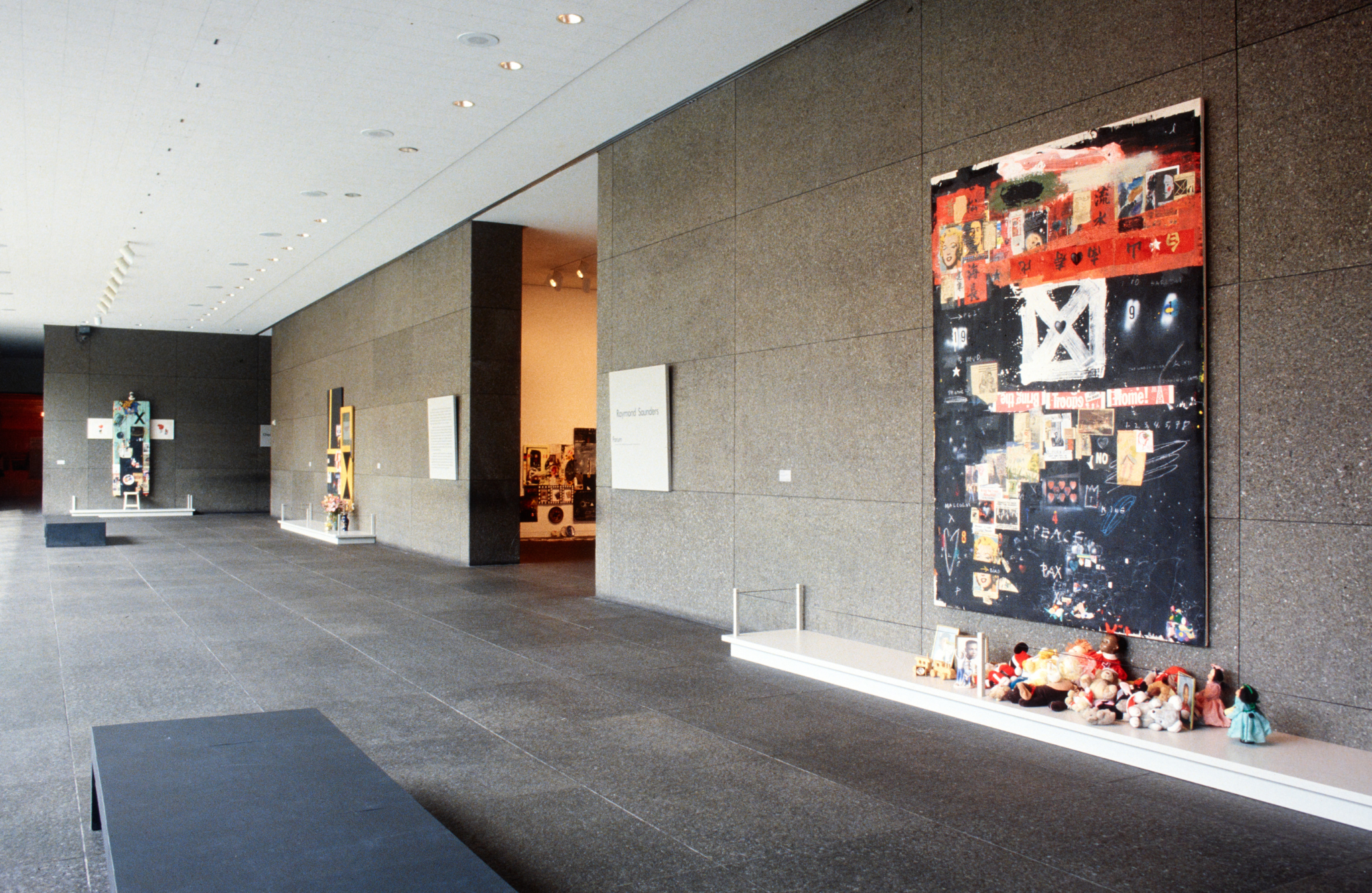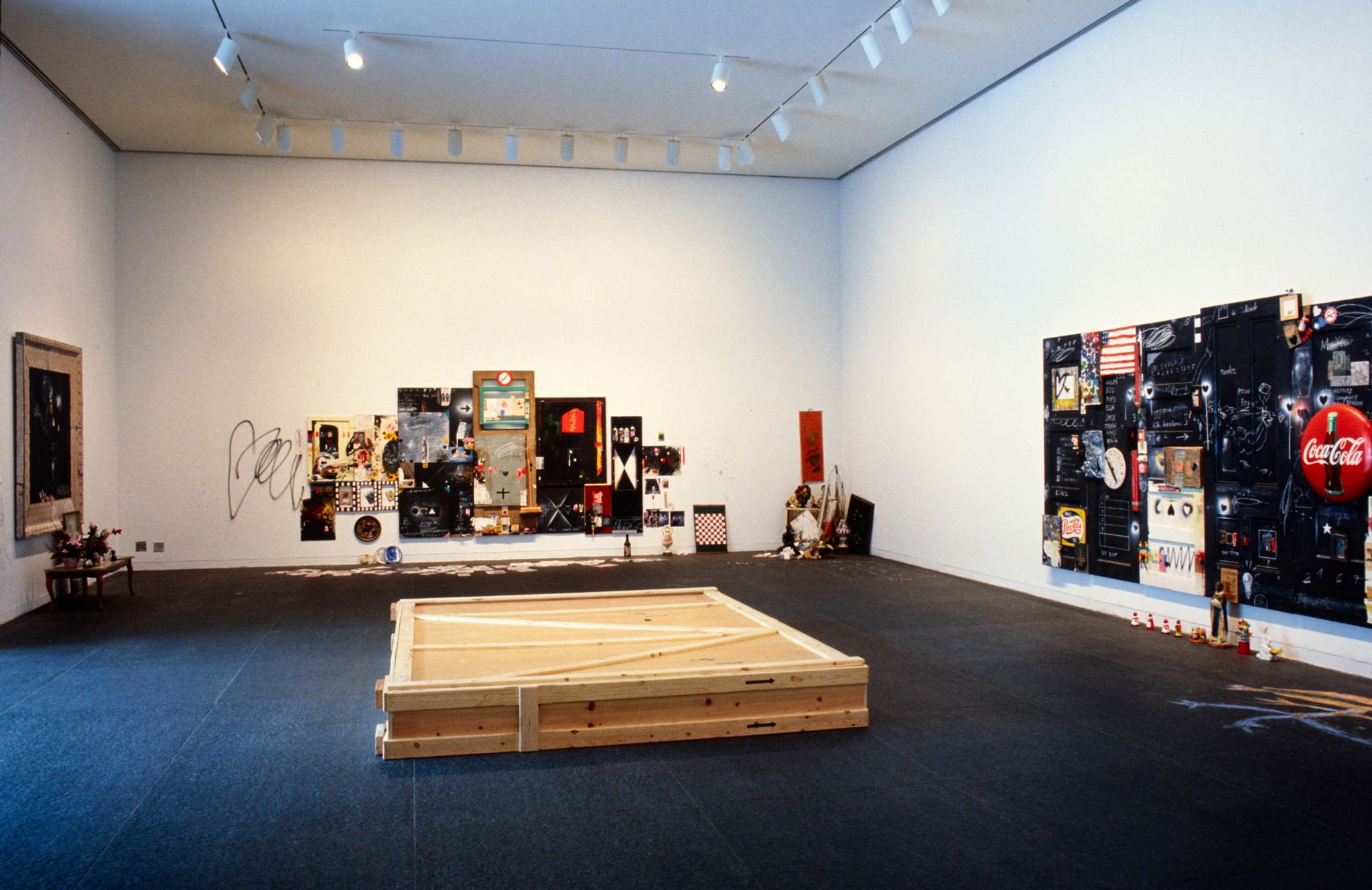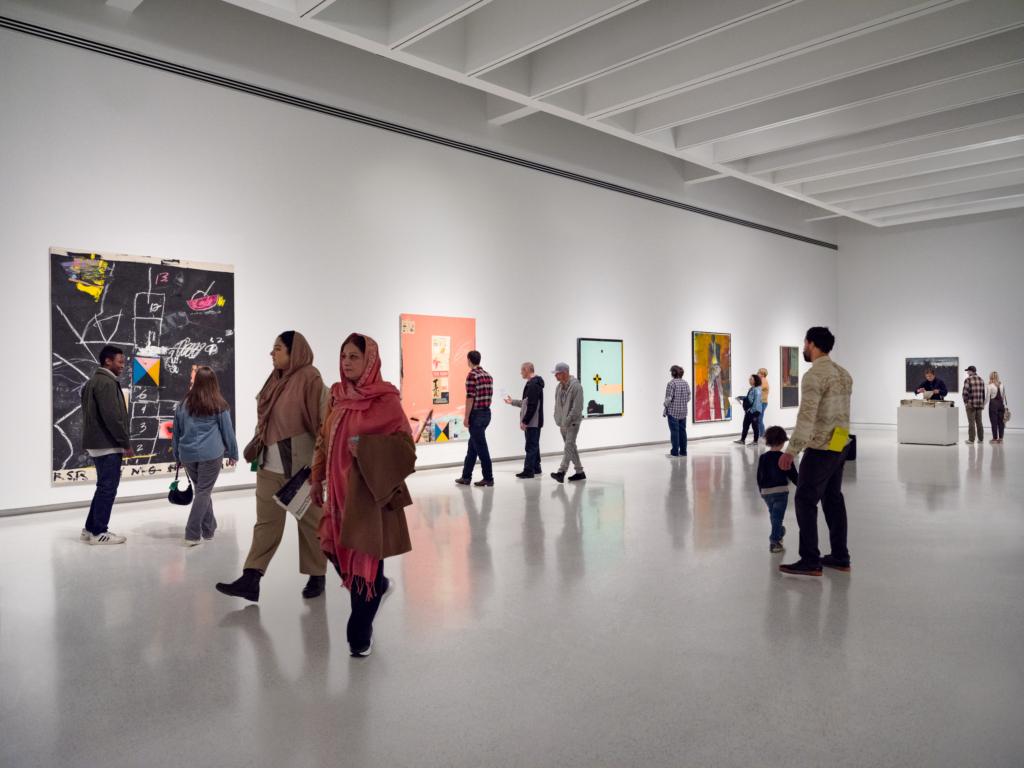
Raymond Saunders

A Note to the Reader
This curatorial essay originally appeared in an in-gallery pamphlet published on the occasion of Raymond Saunders, a 1996 exhibition at Carnegie Museum of Art organized as part of the Forum Series.
Raymond Saunders
The recent work by Raymond Saunders on view here includes some of the artist’s largest and most symbol-filled paintings to date. Saunders’s images are both invented and appropriated. Further, he often joins fragments of his handwriting with found texts. In combining the private and public imagery, he invites us to see differently—more allusively and with a greater sense of wonder. As viewers, we are caught up in his associative monologue, with its autobiographical elements as touchstones. An obvious example here is Joseph Fitzpatrick Was Our Teacher (1991), the artist’s homage to the longtime art instructor at the Carnegie.

Saunders was born and raised in Pittsburgh’s Hill District; through his work he gives voice to recent African-American history. His “black paintings,” begun twenty years ago, are, in fact, black backgrounds on which he paints, writes, and adheres objects in an evolving process that fuses particular cultural and racial memories to wider artistic ones. Saunders is a visual historian, recording and recreating his impressions of places and events ranging from his Pittsburgh childhood in the 1930s and 1940s to the present. He attended SoHo Elementary School, where his prodigious talent as an artist was evident at an early age. He went on to Fifth Avenue High School and then transferred to Schenley High School in order to study with Joseph Fitzpatrick. Fitzpatrick also headed the Carnegie’s Saturday classes, organized by age into the “Tam O’Shanters” and “Palette” classes. His enthusiastic guidance became legendary. In the painted homage included here, Saunders uses two reproductions of a Marilyn painting by Andy Warhol, another well-known Schenley High-Carnegie student of Fitzpatrick’s. The iconic Marilyns co-exist with an array of clippings and paper scraps arranged around a large boxed X on which a small black heart has been superimposed. Fragments of flyers protesting the Gulf War are juxtaposed and rearranged amidst a firmament of Chinese calligraphy and other printed and drawn ephemera. As usual, Saunders’s visual alchemy ultimately renders the picture a layered, essentially abstract, composition. His narratives wander freely. Chronological sequence is fluid, and the story being told is an impressionistic one.
At age fifteen, Saunders’s work was featured in a solo exhibition at the Pittsburgh Playhouse that attracted favorable attention from the public and the press. He attended art classes at Carnegie Tech before a Scholastic magazine scholarship allowed him to enroll at the famed Pennsylvania Academy of the Fine Arts in Philadelphia. There, Saunders also studied at the nearby Barnes Foundation and University of Pennsylvania. A stint in the army at Fort Ord in northern California introduced him to the extraordinary beauty of the West Coast. He came back to Pittsburgh, earning a B.F.A. at Carnegie Tech in 1960, then returned to the Bay Area, where he received an M.F.A. at California College of Arts and Crafts in 1961. Saunders has taught there since.
Beginning with Pittsburgh—which he recalls fondly as a place of “hills and grass and green trees”—cities have been important to Saunders. His work, resembling elegant graffiti, has a distinctly urban cast. Saunders maintains studios in Oakland and Venice, California, as well as in Paris. He is a constant and wide-ranging traveler, relishing the demand “to be present and to interact. I travel to see and to observe. I want to stay engaged with how I feel and what I see.” Saunders has visited Mexico often, citing an affinity for the tonality and texture of its culture. He has also traveled to China, loving the meticulous beauty of the calligraphy and the brilliant reds that dominate the country’s public coloration. Wherever he goes, Saunders walks the streets, looking for and often salvaging detritus—some of it destined to be incorporated in his later work.
He is the vision of a city walker, and his work provokes a comparable vision for its viewers. It is a democratic and inclusive mode accommodating many readings. Saunders works on the studio floor, hovering above the picture plane, adding and subtracting at will. He reconfigures the whole to suggest new roles for each part, his choices aided by the bits and pieces of things he collects at hand. Like the jazz musicians whose names so often appear in his work, Saunders improvises new sounds from existing notes.
The most ambitious exposition of this technique to date is the recent and monumental painting, The Gift of Presence (1993). Gracing it with a double entendre, Saunders utilizes six wooden doors as the work’s support. An abundant lexicon of words and drawn images moves the eye across contiguous surfaces enlivened with a variety of found objects—most prominently a large circular Coca-Cola advertisement and a Pepsi placard in French. Saunders’s litany of great jazz musicians—Charlie “Bird” Parker, Miles Davis, “Dizz” Gillespie, and others—as well as such geographic inscriptions as “Pittsburgh” and “Harlem” suggest this piece as an extended cultural elegy.

Other recent works such as Malcolm X: Talking Pictures (1994), Urban Talk (1993), and Not Always Invited to Dinner (1995) are somewhat grittier demonstrations of Saunders’s aesthetic. The last assemblage, in particular—with its masked head, large black X, and old clippings about integration in Alabama, George Wallace, the FBI, and Malcolm X—shows Saunders as a visionary rooted in reality.
Further Reading
- Nash, Steven A. Raymond Saunders: Black Paintings, exhibition brochure, (San Francisco: M. H. de Young Memorial Museum, 1995).
- Linhares, Philip. Raymond Saunders: Recent Work, exhibition catalogue, (Oakland: Oakland Museum, 1994).
- Santiago, Chiori. “The Elusive Raymond Saunders,” The Museum of California (The Oakland Museum) 18 (Winter, 1994), pp. 4–9.
- Morris, Gay. “Raymond Saunders: Improvising with High and Low,” Art in America (February 1995), pp. 86–89 and 108.
About the Artist
Raymond Saunders was born in Pittsburgh in 1934. He attended Schenley High School and trained at Saturday classes at the Carnegie. He studied at Carnegie Institute of Technology (1950–53), the Pennsylvania Academy of the Fine Arts (1953–57), and the University of Pennsylvania (1954–57). He received a B.F.A. at Carnegie Institute of Technology (1960) and an M.F.A. at California College of Arts and Crafts (1961), where he teaches. Saunders’s work has been presented in numerous one-artist and group exhibitions, most recently at the Oakland Museum (1994) and the M. H. de Young Memorial Museum, San Francisco (1995). The artist lives and works in Oakland, California.
Richard Armstrong was previously the Henry J. Heinz II Director at Carnegie Museum of Art, Pittsburgh where he began as a curator in 1992. Following an extensive national search Richard Armstrong, the chief curator of Carnegie Museum of Art and an expert in contemporary art, was named the eighth director of the museum. He succeeded Phillip M. Johnston and assumed his duties as the Henry J. Heinz II Director of Carnegie Museum of Art on Friday, August 30.
Armstrong joined the museum in 1992 as curator of contemporary art and three years later he became chief curator, the same year in which the 52nd Carnegie International, which he organized for the centennial year, opened to the public. In making the announcement of the new director, president Ellsworth Brown noted the profound effect Armstrong had already made on the collections and exhibitions, and said he expected him to become “a particularly compelling director” of the museum because of his strong aesthetic vision, ability to work with all sectors of the museum world, and his strong organizational sense.
Born and educated in Kansas City, Missouri, Armstrong studied at the University de Dijon and the Sorbonne in Paris, and received a B.A. in Art History from Lake Forest College, Illinois. He was a Helene Rubenstein Fellow at the Whitney Museum of American Art, and afterwards worked as a curator at La Jolla Museum of Contemporary Art, California, and in 1980 served on the artists committee that planned the Museum of Contemporary Art, Los Angeles. Beginning in 1981 he was associated with the Whitney Museum again, starting as a senior instructor and rising to curator in 1989. He co-organized four of the Whitney’s well-known Biennial exhibitions, and organized other exhibitions of contemporary art such as Richard Artschwager (1988) and The New Sculpture 1965-7. He has served as a guest curator at the Pennsylvania Academy of Arts and at Palacio Velasquez, Madrid, and has lectured widely and been published in a number of periodicals.
Armstrong went on to become the Director of the Solomon R. Guggenheim Foundation and its constellation of museums, including the Guggenheim Museum, New York; the Peggy Guggenheim Collection, Venice; the Guggenheim Museum Bilbao; and the future Guggenheim Abu Dhabi. Armstrong also served on the Foundation’s Board of Trustees.
Related Exhibitions

